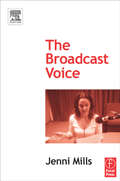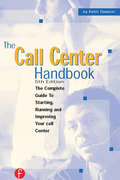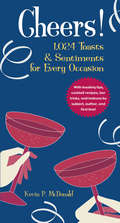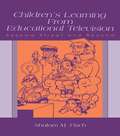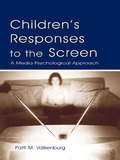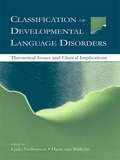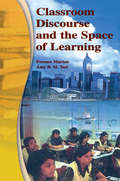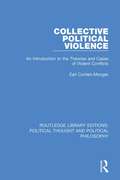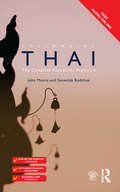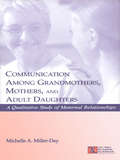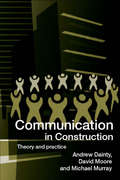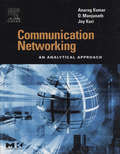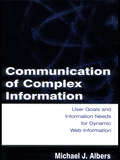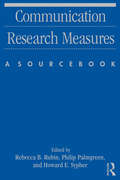- Table View
- List View
The Broadcast Voice
by Jenni MillsAnyone working - or aspiring to work - as a radio or TV presenter will benefit from Jenni Mills' experience. This inspirational book and tutorial-packed CD provide unique access to the advice previously only available through her one-on-one coaching sessions. Jenni teaches how to get the best from your voice in front of the microphone through techniques and exercises designed specifically for broadcasting. She covers both the physical aspects of voice production and the mind-set needed to broadcast with authority and warmth. Audio and video clips on the accompanying CD-Rom illustrate the dos and don'ts discussed in the book as well as demonstrating voice exercises.
The Call Center Handbook: The Complete Guide to Starting, Running, and Improving Your Call Center
by Keith DawsonNeed to know how to buy a phone switch for your call center? How to measure the productivity of agents? How to choose from two cities that both want your center? No problem. The Call Center Handbook is a complete guide to starting, running, and im
Cheers!: 1,024 Toasts & Sentiments for Every Occasion
by Kevin P. McDonaldCheers! is an indispensable A-to-Z of warm, funny, erudite, and sentimental sayings forevery possible occasion. Organized by category, Cheers! is more than a list of notable quotes and memorable toasts. It is full of useful advice on how to prepare a personalized message using the sayings in the book; deliver a toast without becoming flustered or, worse, running too long; and determine what words are appropriate for any given situation. An extended index and cross-references make Cheers! extremely easy to navigate, so finding the perfect words is a cinch.
Children, Youth and Adults with Asperger Syndrome: Integrating Multiple Perspectives
by Peter Szatmari Lillian Burke Isabelle Henault Leon Sloman Peter Jansen M. Mary Konstantareas Faye Mishna Rosina G. Schnurr Barbara Muskat Trina Epstein Jennifer Saltzman-Benaiah Gail Hawkins Tracie Lindblad S. Wendy Roberts Tamarah Kagan-Kushnir Georgina Rayner Paula Aquilla Ellen Yack Shirley Sutton Charmaine C. Williams Jonathan Leef Jeanette J. Holden Ann Fudge Schormans Fern Lee Quint Donna Moon Margot Nelles Chris J. DakinThis book offers a comprehensive overview of clinical, research and personal perspectives on Asperger Syndrome, including contributions from parents and experts in the fields of psychology, social work, psychiatry, genetics, sexology and vocational counselling.
Children's Learning From Educational Television: Sesame Street and Beyond
by Shalom M. FischAt its best, educational television can provide children with enormous opportunities and can serve as a window to new experiences, enrich academic knowledge, enhance attitudes and motivation, and nurture social skills. This volume documents the impact of educational television in a variety of subject areas and proposes mechanisms to explain its effects. Drawing from a wide variety of research spanning several disciplines, author Shalom M. Fisch analyzes the literature on the impact of educational resources. He focuses on television programs designed for children rather than for adults, although adult literature is included when it is particularly relevant. In addition, much of the discussion concerns the effects of unaided viewing by children, rather than viewing in the context of adult-led follow-up activities. The role of parent-child co-viewing and issues relevant to the use of television in school or child care also receives consideration. This volume is intended to make the disparate literature on educational television's impact more accessible, by bringing it together into a centralized resource. To that end, the volume draws together empirical data on the impact of educational television programs--both academic and prosocial--on children's knowledge, skills, attitudes, and behavior. In addition to its emphasis on positive effects, this volume addresses a gap in the existing research literature regarding children's learning from exposure to educational television. Acknowledging that little theoretical work has been done to explain why or how these effects occur, Fisch takes a step toward correcting this situation by proposing theoretical models to explore aspects of the mental processing that underlies children's learning from educational television. With its unique perspective on children's educational television and comprehensive approach to studying the topic, this volume is required reading for scholars, researchers, and students working in the area of children and television. It offers crucial insights to scholars in developmental psychology, family studies, educational psychology, and related areas.
Children's Learning From Educational Television: Sesame Street and Beyond
by Shalom M. FischAt its best, educational television can provide children with enormous opportunities and can serve as a window to new experiences, enrich academic knowledge, enhance attitudes and motivation, and nurture social skills. This volume documents the impact of educational television in a variety of subject areas and proposes mechanisms to explain its effects. Drawing from a wide variety of research spanning several disciplines, author Shalom M. Fisch analyzes the literature on the impact of educational resources. He focuses on television programs designed for children rather than for adults, although adult literature is included when it is particularly relevant. In addition, much of the discussion concerns the effects of unaided viewing by children, rather than viewing in the context of adult-led follow-up activities. The role of parent-child co-viewing and issues relevant to the use of television in school or child care also receives consideration. This volume is intended to make the disparate literature on educational television's impact more accessible, by bringing it together into a centralized resource. To that end, the volume draws together empirical data on the impact of educational television programs--both academic and prosocial--on children's knowledge, skills, attitudes, and behavior. In addition to its emphasis on positive effects, this volume addresses a gap in the existing research literature regarding children's learning from exposure to educational television. Acknowledging that little theoretical work has been done to explain why or how these effects occur, Fisch takes a step toward correcting this situation by proposing theoretical models to explore aspects of the mental processing that underlies children's learning from educational television. With its unique perspective on children's educational television and comprehensive approach to studying the topic, this volume is required reading for scholars, researchers, and students working in the area of children and television. It offers crucial insights to scholars in developmental psychology, family studies, educational psychology, and related areas.
Children's Responses to the Screen: A Media Psychological Approach (Routledge Communication Series)
by Patti M. ValkenburgThe past several decades have witnessed thousands of studies into children and the media. Yet, much academic research is still in its infancy when it comes to our knowledge about the uses, preferences, and effects of different media. This distinctive volume moves the field forward in this regard, with its insights into the latest theories and research on children and the media. Author Patti M. Valkenburg explores "screen" media (i.e., television, films, video and computer games, and the Internet), and focuses her study on the most fundamental topics in the study of children and the media. In each chapter, Valkenburg examines an essential topic on children and the media: the effect of media violence, children's emotional reactions to news and entertainment, the intended and unintended effects of advertising, and the uses and effects of computer games and the Internet. She has structured the chapters to provide an overview of existing theories and research on a particular topic, and supplements the work of others with her own ground-breaking research findings. She provides a careful and even-handed treatment of research in children's media, and includes current and noteworthy studies. As a resource for study in children and media and media psychology, this volume provides a timely and thorough examination of the state of theory and research. It will serve as a valuable reference for scholars and as an engaging text for advanced students.
Children's Responses to the Screen: A Media Psychological Approach (Routledge Communication Series)
by Patti M. ValkenburgThe past several decades have witnessed thousands of studies into children and the media. Yet, much academic research is still in its infancy when it comes to our knowledge about the uses, preferences, and effects of different media. This distinctive volume moves the field forward in this regard, with its insights into the latest theories and research on children and the media. Author Patti M. Valkenburg explores "screen" media (i.e., television, films, video and computer games, and the Internet), and focuses her study on the most fundamental topics in the study of children and the media. In each chapter, Valkenburg examines an essential topic on children and the media: the effect of media violence, children's emotional reactions to news and entertainment, the intended and unintended effects of advertising, and the uses and effects of computer games and the Internet. She has structured the chapters to provide an overview of existing theories and research on a particular topic, and supplements the work of others with her own ground-breaking research findings. She provides a careful and even-handed treatment of research in children's media, and includes current and noteworthy studies. As a resource for study in children and media and media psychology, this volume provides a timely and thorough examination of the state of theory and research. It will serve as a valuable reference for scholars and as an engaging text for advanced students.
Classification of Developmental Language Disorders: Theoretical Issues and Clinical Implications
by Ludo Verhoeven Hans Van BalkomChapters written by leading authorities offer current perspectives on the origins and development of language disorders. They address the question: How can the child's linguistic environment be restructured so that children at risk can develop important adaptive skills in the domains of self-care, social interaction, and problem solving? This theory-based, but practical book emphasizes the importance of accurate definitions of subtypes for assessment and intervention. It will be of interest to students, researchers, and practitioners in the field of developmental language disorders.
Classification of Developmental Language Disorders: Theoretical Issues and Clinical Implications
by Ludo Verhoeven Hans Van BalkomChapters written by leading authorities offer current perspectives on the origins and development of language disorders. They address the question: How can the child's linguistic environment be restructured so that children at risk can develop important adaptive skills in the domains of self-care, social interaction, and problem solving? This theory-based, but practical book emphasizes the importance of accurate definitions of subtypes for assessment and intervention. It will be of interest to students, researchers, and practitioners in the field of developmental language disorders.
Classroom Discourse and the Space of Learning
by Ference Marton Amy B.M. Tsui Pakey P.M. Chik Po Yuk Ko Mun Ling LoClassroom Discourse and the Space of Learning is about learning in schools and the central role of language in learning. The investigations of learning it reports are based on two premises: First, whatever you are trying to learn, there are certain necessary conditions for succeeding--although you cannot be sure that learning will take place when those conditions are met, you can be sure that no learning will occur if they are not. The limits of what is possible to learn is what the authors call "the space of learning." Second, language plays a central role in learning--it does not merely convey meaning, it also creates meaning. The book explicates the necessary conditions for successful learning and employs investigations of classroom discourse data to demonstrate how the space of learning is linguistically constituted in the classroom.Classroom Discourse and the Space of Learning:*makes the case that an understanding of how the space of learning is linguistically constituted in the classroom is best achieved through investigating "classroom discourse" and that finding out what the conditions are for successful learning and bringing them about should be the teacher's primary professional task. Thus, it is fundamentally important for teachers and student teachers to be given opportunities to observe different teachers teaching the same thing, and to analyze and reflect on whether the classroom discourse in which they are engaged maximizes or minimizes the conditions for learning;*is both more culturally situated and more generalizable than many other studies of learning in schools. Each case of classroom teaching clearly demonstrates how the specific language, culture, and pedagogy molds what is happening in the classroom, yet at the same time it is possible to generalize from these culturally specific examples the necessary conditions that must be met for the development of any specific capability regardless of where the learning is taking place and what other conditions might be present; and *encompasses both theory and practice--providing a detailed explication of the theory of learning underlying the analyses of classroom teaching reported, along with close analyses of a number of authentic cases of classroom teaching driven by classroom discourse data which have practical relevance for teachers.Intended for researchers and graduate students in education, teacher educators, and student teachers, Classroom Discourse and the Space of Learning is practice- and content-oriented, theoretical, qualitative, empirical, and focused on language, and links teaching and learning in significant new ways.
Classroom Discourse and the Space of Learning
by Ference Marton Amy B.M. Tsui Pakey P.M. Chik Po Yuk Ko Mun Ling LoClassroom Discourse and the Space of Learning is about learning in schools and the central role of language in learning. The investigations of learning it reports are based on two premises: First, whatever you are trying to learn, there are certain necessary conditions for succeeding--although you cannot be sure that learning will take place when those conditions are met, you can be sure that no learning will occur if they are not. The limits of what is possible to learn is what the authors call "the space of learning." Second, language plays a central role in learning--it does not merely convey meaning, it also creates meaning. The book explicates the necessary conditions for successful learning and employs investigations of classroom discourse data to demonstrate how the space of learning is linguistically constituted in the classroom.Classroom Discourse and the Space of Learning:*makes the case that an understanding of how the space of learning is linguistically constituted in the classroom is best achieved through investigating "classroom discourse" and that finding out what the conditions are for successful learning and bringing them about should be the teacher's primary professional task. Thus, it is fundamentally important for teachers and student teachers to be given opportunities to observe different teachers teaching the same thing, and to analyze and reflect on whether the classroom discourse in which they are engaged maximizes or minimizes the conditions for learning;*is both more culturally situated and more generalizable than many other studies of learning in schools. Each case of classroom teaching clearly demonstrates how the specific language, culture, and pedagogy molds what is happening in the classroom, yet at the same time it is possible to generalize from these culturally specific examples the necessary conditions that must be met for the development of any specific capability regardless of where the learning is taking place and what other conditions might be present; and *encompasses both theory and practice--providing a detailed explication of the theory of learning underlying the analyses of classroom teaching reported, along with close analyses of a number of authentic cases of classroom teaching driven by classroom discourse data which have practical relevance for teachers.Intended for researchers and graduate students in education, teacher educators, and student teachers, Classroom Discourse and the Space of Learning is practice- and content-oriented, theoretical, qualitative, empirical, and focused on language, and links teaching and learning in significant new ways.
Collective Political Violence: An Introduction to the Theories and Cases of Violent Conflicts (Routledge Library Editions: Political Thought and Political Philosophy #16)
by Earl Conteh-MorganFirst published in 2004. Collective Political Violence is a concise, but thorough, interdisciplinary analysis of the many competing concepts, theories, and explanations of political conflict, including revolutions, civil wars, genocide, and terrorism. To further his examination of each type of conflict, Earl Conteh-Morgan presents case studies, from the Rwandan genocide to the civil rights movement in the United States. Along the way, he illuminates new debates concerning terrorism, peacekeeping, and environmental security. Written in a knowledgeable, yet accessible, manner, Collective Political Violence treats the issue of political violence with on impressively wide geographic range, and successfully straddles the ideological divide.
Collective Political Violence: An Introduction to the Theories and Cases of Violent Conflicts (Routledge Library Editions: Political Thought and Political Philosophy #16)
by Earl Conteh-MorganFirst published in 2004. Collective Political Violence is a concise, but thorough, interdisciplinary analysis of the many competing concepts, theories, and explanations of political conflict, including revolutions, civil wars, genocide, and terrorism. To further his examination of each type of conflict, Earl Conteh-Morgan presents case studies, from the Rwandan genocide to the civil rights movement in the United States. Along the way, he illuminates new debates concerning terrorism, peacekeeping, and environmental security. Written in a knowledgeable, yet accessible, manner, Collective Political Violence treats the issue of political violence with on impressively wide geographic range, and successfully straddles the ideological divide.
Colloquial Hebrew
by Zippi Lyttleton Tamar WangColloquial Hebrew provides a step-by-step course in Hebrew as it is written and spoken today. Combining a user-friendly approach with a thorough treatment of the language, it equips learners with the essential skills needed to communicate confidently and effectively in Hebrew in a broad range of situations. No prior knowledge of the language is required. Key features include: • progressive coverage of speaking, listening, reading and writing skills • structured, jargon-free explanations of grammar • an extensive range of focused and stimulating exercises • realistic and entertaining dialogues covering a broad variety of scenarios • useful vocabulary lists throughout the text • additional resources available at the back of the book, including a full answer key, a grammar summary and bilingual glossaries Balanced, comprehensive and rewarding, Colloquial Hebrew will be an indispensable resource both for independent learners and students taking courses in Hebrew. Audio material to accompany the course is available to download freely in MP3 format from www.routledge.com/cw/colloquials. Recorded by native speakers, the audio material features the dialogues and texts from the book and will help develop your listening and pronunciation skills.
Colloquial Thai: The Complete Course For Beginners (Colloquial Ser.)
by John Moore Saowalak RodchueColloquial Thai: The Complete Course for Beginners has been carefully developed by an experienced teacher to provide a step-by-step course to Thai as it is written and spoken today. Combining a clear, practical and accessible style with a methodical and thorough treatment of the language, it equips learners with the essential skills needed to communicate confidently and effectively in Thai in a broad range of situations. No prior knowledge of the language is required. Colloquial Thai is exceptional; each unit presents a wealth of grammatical points that are reinforced with a wide range of exercises for regular practice. A full answer key, a grammar summary, bilingual glossaries and English translations of dialogues can be found at the back as well as useful vocabulary lists throughout. Key features include: A clear, user-friendly format designed to help learners progressively build up their speaking, listening, reading and writing skills Jargon-free, succinct and clearly structured explanations of grammar An extensive range of focused and dynamic supportive exercises Realistic and entertaining dialogues covering a broad variety of narrative situations Helpful cultural points explaining the customs and features of life in Thailand. An overview of the sounds of Thai Balanced, comprehensive and rewarding, Colloquial Thai is an indispensable resource both for independent learners and students taking courses in Thai. Audio material to accompany the course is available to download free in MP3 format from www.routledge.com/cw/colloquials. Recorded by native speakers, the audio material features the dialogues and texts from the book and will help develop your listening and pronunciation skills.
Colloquial Thai
by John Moore Saowalak RodchueColloquial Thai: The Complete Course for Beginners has been carefully developed by an experienced teacher to provide a step-by-step course to Thai as it is written and spoken today. Combining a clear, practical and accessible style with a methodical and thorough treatment of the language, it equips learners with the essential skills needed to communicate confidently and effectively in Thai in a broad range of situations. No prior knowledge of the language is required. Colloquial Thai is exceptional; each unit presents a wealth of grammatical points that are reinforced with a wide range of exercises for regular practice. A full answer key, a grammar summary, bilingual glossaries and English translations of dialogues can be found at the back as well as useful vocabulary lists throughout. Key features include: A clear, user-friendly format designed to help learners progressively build up their speaking, listening, reading and writing skills Jargon-free, succinct and clearly structured explanations of grammar An extensive range of focused and dynamic supportive exercises Realistic and entertaining dialogues covering a broad variety of narrative situations Helpful cultural points explaining the customs and features of life in Thailand. An overview of the sounds of Thai Balanced, comprehensive and rewarding, Colloquial Thai is an indispensable resource both for independent learners and students taking courses in Thai. Audio material to accompany the course is available to download free in MP3 format from www.routledge.com/cw/colloquials. Recorded by native speakers, the audio material features the dialogues and texts from the book and will help develop your listening and pronunciation skills.
Communication Among Grandmothers, Mothers, and Adult Daughters: A Qualitative Study of Maternal Relationships (LEA's Series on Personal Relationships)
by Michelle A. Miller-DayThis volume examines communication processes within the grandmother-mother-daughter relationship, emphasizing an intergenerational perspective. Using observations of and extensive interviews with six sets of middle-income, Caucasian female family members, this book offers a heuristic account of intergenerational mother-daughter relational communication.Author Michelle Miller-Day integrates and juxtaposes alternative experiences of social interaction, situating readers in the world of grandmothers, mothers, adult daughters, and granddaughters as they experience, describe, and analyze their family communication. Miller-Day incorporates aged mothers and younger mid-life mothers and their adult daughters into the research to illustrate how this type of maternal relationship is experienced at different points in a woman's life. With the inclusion of three generations of women, Miller-Day offers multigenerational perspectives on family, and examines them for patterns of maternal interaction, providing symbolic links across generational boundaries.Communication Among Grandmothers, Mothers, and Adult Daughters enables readers to understand more completely the richly textured nature of maternal relationships. It will be an invaluable resource for scholars and researchers in the areas of communication and relationships, including family communication, intergenerational communication, women's studies, family studies, interpersonal communication, and relationships, as well as social workers, psychologists, and counselors, who strive to understand family communication processes and their dynamics across generational lines.
Communication in Construction: Theory and Practice
by Andrew Dainty David Moore Michael MurrayCommunication within project-based environments presents special challenges. This is especially true within the construction industry, where interaction tends to be characterised by unfamiliar groups of people coming together for short periods before disbanding to work on other endeavours. This book examines communication at a number of levels ranging from interpersonal interactions between project participants to corporate communication between organizations. Several non-typical perspectives on the process of communication are introduced to encourage the reader to think about communication in a more innovative manner. The combination of differing perspectives illustrates the diversity of communication problems facing those working within project-based environments. Practical guidance is provided on possible solutions to communication problems, and a number of examples and case studies are presented.
Communication in Construction: Theory and Practice
by Andrew Dainty David Moore Michael MurrayCommunication within project-based environments presents special challenges. This is especially true within the construction industry, where interaction tends to be characterised by unfamiliar groups of people coming together for short periods before disbanding to work on other endeavours. This book examines communication at a number of levels ranging from interpersonal interactions between project participants to corporate communication between organizations. Several non-typical perspectives on the process of communication are introduced to encourage the reader to think about communication in a more innovative manner. The combination of differing perspectives illustrates the diversity of communication problems facing those working within project-based environments. Practical guidance is provided on possible solutions to communication problems, and a number of examples and case studies are presented.
Communication Networking: An Analytical Approach (ISSN)
by Anurag Kumar D. Manjunath Joy KuriCommunication Networking is a comprehensive, effectively organized introduction to the realities of communication network engineering. Written for both the workplace and the classroom, this book lays the foundation and provides the answers required for building an efficient, state-of-the-art network—one that can expand to meet growing demand and evolve to capitalize on coming technological advances. It focuses on the three building blocks out of which a communication network is constructed: multiplexing, switching, and routing. The discussions are based on the viewpoint that communication networking is about efficient resource sharing. The progression is natural: the book begins with individual physical links and proceeds to their combination in a network. The approach is analytical: discussion is driven by mathematical analyses of and solutions to specific engineering problems. Fundamental concepts are explained in detail and design issues are placed in context through real world examples from current technologies. The text offers in-depth coverage of many current topics, including network calculus with deterministically-constrained traffic; congestion control for elastic traffic; packet switch queuing; switching architectures; virtual path routing; and routing for quality of service. It also includes more than 200 hands-on exercises and class-tested problems, dozens of schematic figures, a review of key mathematical concepts, and a glossary. This book will be of interest to networking professionals whose work is primarily architecture definition and implementation, i.e., network engineers and designers at telecom companies, industrial research labs, etc. It will also appeal to final year undergrad and first year graduate students in EE, CE, and CS programs.Systematically uses mathematical models and analyses to drive the development of a practical understanding of core network engineering problems.Provides in-depth coverage of many current topics, including network calculus with deterministically-constrained traffic, congestion control for elastic traffic, packet switch queuing, switching architectures, virtual path routing, and routing for quality of service.Includes over 200 hands-on exercises and class-tested problems, dozens of schematic figures, a review of key mathematical concepts, and a glossary.
Communication of Complex Information: User Goals and Information Needs for Dynamic Web Information
by Michael J. AlbersThe amount of information available for any realistic complex situation is likely to overwhelm most users, as well as stymie any designer tasked with presenting the information. Providing large amounts of information in a coherent and usable format remains an unresolved problem. Choosing, structuring, formatting, and displaying information to allow easy access and to facilitate understanding are critical issues for effective design. To build an effective design that addresses complex information needs, one must look at research from psychology, sociology, human computer interaction, and technical communication, and develop a complete picture of the situation. This book develops a foundation for analysis and design of the approaches to providing complex information in real-world situations. Author Michael Albers takes the view that the content of the information system is the most important component. As such, this volume presents the analysis that needs to be done before the interface is designed and before content is created. It strives to provide clear understanding of how the user thinks and what the user needs, so interface operation, content, and presentation can maximize their respective potentials in communicating with a user. This volume is intended for technical communicators, human-computer interaction designers, and information designers. It will also be useful for system designers and researchers, and those studying adaptive hypertext and related topics.
Communication of Complex Information: User Goals and Information Needs for Dynamic Web Information
by Michael J. AlbersThe amount of information available for any realistic complex situation is likely to overwhelm most users, as well as stymie any designer tasked with presenting the information. Providing large amounts of information in a coherent and usable format remains an unresolved problem. Choosing, structuring, formatting, and displaying information to allow easy access and to facilitate understanding are critical issues for effective design. To build an effective design that addresses complex information needs, one must look at research from psychology, sociology, human computer interaction, and technical communication, and develop a complete picture of the situation. This book develops a foundation for analysis and design of the approaches to providing complex information in real-world situations. Author Michael Albers takes the view that the content of the information system is the most important component. As such, this volume presents the analysis that needs to be done before the interface is designed and before content is created. It strives to provide clear understanding of how the user thinks and what the user needs, so interface operation, content, and presentation can maximize their respective potentials in communicating with a user. This volume is intended for technical communicators, human-computer interaction designers, and information designers. It will also be useful for system designers and researchers, and those studying adaptive hypertext and related topics.
Communication Research Measures: A Sourcebook (Routledge Communication Series)
by Rebecca B. Rubin Philip Palmgreen Howard E. SypherThe development of communication as a discipline has resulted in an explosion of scales tapping various aspects of interpersonal, mass, organizational, and instructional communication. This sourcebook brings together scales that measure a variety of important communication constructs. The scales presented are drawn from areas of interpersonal, mass, organizational, and instructional communication--areas in which the use of formal, quantitative scales is particularly well developed. Communication Research Measures reflects the recent important emphasis on developing and improving the measurement base of the communication discipline. It results in an equal amount of labor saved on the part of the scholars, students, and practitioners who find this book useful, and it contributes in a significant way to research efforts.Originally published by Guilford Press in 1994, now available from Routledge.
Communication Research Measures: A Sourcebook (Routledge Communication Series)
by Rebecca B. Rubin Philip Palmgreen Howard E. SypherThe development of communication as a discipline has resulted in an explosion of scales tapping various aspects of interpersonal, mass, organizational, and instructional communication. This sourcebook brings together scales that measure a variety of important communication constructs. The scales presented are drawn from areas of interpersonal, mass, organizational, and instructional communication--areas in which the use of formal, quantitative scales is particularly well developed. Communication Research Measures reflects the recent important emphasis on developing and improving the measurement base of the communication discipline. It results in an equal amount of labor saved on the part of the scholars, students, and practitioners who find this book useful, and it contributes in a significant way to research efforts.Originally published by Guilford Press in 1994, now available from Routledge.
